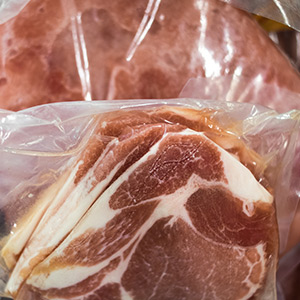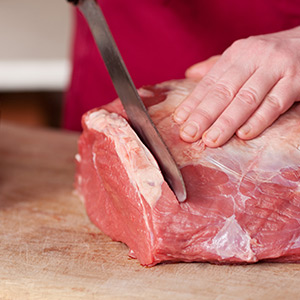- 5 unforgettable BBQ marinades
- How to Make a Perfect Roast Every Time
- Filet mignon: different recipes for different cuts
- Guide to Cooking Beef
- Tips on How to BBQ Like a Pro
- 5 Ways To Reinvent the Burger
- Prepare and Cook Sausages
- Skewers Bar: Pile Up on Flavour
- 6 Pork Cuts You’re Sure to Love
- Spices to Flavour Meat
- Soul Food at Home
Meat Buying Tips Safe Handling
The basics of safe meat handling

The food and agriculture industry works hard to guarantee quality meats to consumers. Rigorous controls are imposed on all stages of production, including breeding, slaughter, processing and marketing. Still, there are risks of bacteria contamination between the time meats are purchased and when they are prepared and cooked. This is why it is important to be vigilant and observe certain basic rules to cook safely.

Shopping
- Grab your meat last, in order to reduce the amount of time it is not refrigerated.
- Choose very cold and well-wrapped meats.
- Verify the packaging date and the best-before date on the label.
- Place poultry and other meats in a plastic bag or put them in an area of your grocery basket or cart where the liquids cannot drain on any other food.
Storage
- Keep meats at 0-4° C (32-40° F), or freeze meats and poultry as soon as you get home from the store. They should never be out of the fridge for more than two hours.
- Keep raw food away from cooked food in the refrigerator.
- Freeze ground meats if they are not going to be cooked the same day. Other cuts can be frozen after two or three days.
- To ensure your fridge is cold enough, place a refrigerator thermometer near the door and check the temperature regularly. Adjust as needed.
- For more information about the storage life of various meats, visit the relevant sections.

Preparation
- Wash utensils, tools, equipment and working surfaces frequently.
- The safest way to clear working surfaces and utensils is to wash them with warm soapy water and a few drops of bleach.
- Separate raw food from cooked food to avoid any cross-contamination. For example: never re-use the dish that carried raw meat to plate the cooked meat.
- Always cook food properly, until it reaches the recommended internal temperature.
- Wash your hands with soap and water before touching food and every time there is a risk of contamination (for example, if you manipulated raw meat or if you’ve sneezed).
Defrosting
- The safest method is to defrost meat in the refrigerator at 0-4;° C (32-40° F).
- Calculate 8-12 hours per kilo (4-6 hours per pound) of meat.
- Place the wrapped frozen meat on a plate on the bottom shelf of the fridge. For poultry, pierce small holes on the bottom of the wrapping.
- You can also defrost meat in the microwave, but when this method is used, cook it immediately after defrosting.
Expert tip
Never defrost meat or poultry at room temperature. This will cause bacteria to multiply on the surface of the meat, even if the inside is still frozen.










